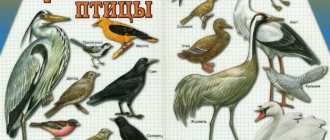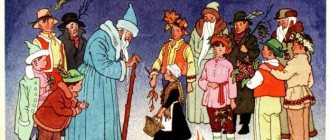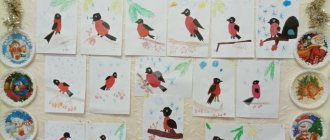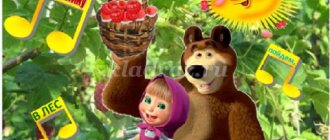Summary of a lesson in the preparatory group of a preschool educational institution. Birds of our city
Lesson notes for preschoolers.
Topic: “Conversation about birds” Objectives of the lesson: Expanding knowledge about the birds of our city. Objectives: to introduce children to the structure of feathers and their significance in the life of birds, to explain the reason for the migration of birds (migratory, wintering, nomadic) to cultivate a caring attitude towards birds; the desire to help birds during a difficult period for them. Preliminary work: bird watching on a walk; looking at illustrations with birds; learning the outdoor game “Birder Catcher”; reading fiction about birds. Equipment: demonstration material “Birds”;
models - diagrams for comparing birds with other animals; feathers of different shapes, colors, sizes; scissors, cups of water; cards for the didactic game “Where do birds winter?”; feeders and various bird food. Progress of the lesson.
Educator: Hello, guys! So autumn has come. What changes have occurred in nature? Children: (list the signs of autumn). Educator : why are there fewer birds? Children: insects disappeared, and birds that feed on insects flew to warmer climes. Educator : Guys, how do birds differ from other animals? Children: (answer based on models - diagrams). Educator : what birds do you know? Children: (list birds). Educator: where do birds fly in the fall? Children: south. Educator : What are the names of the birds that flew south? Children: migratory birds. Educator : What migratory birds do you know? Children: ... Educator: with the onset of cold weather in the fall, the migration of birds begins, this is how it is written about in the poem by E. Blaginina: Soon white snowstorms will raise the snow from the ground. The cranes are flying away, flying away, flying away. You can’t hear the cuckoo in the grove, And the birdhouse is empty, The stork flaps its wings - It flies away, it flies away. A patterned leaf sways in a blue puddle on the water. A black rook and a black rook are walking in the garden, along the ridge. The rare rays of the sun, crumbling and turning yellow, The rooks are flying away, flying away, flying away. Guys, what birds is this poem about? Children: about migratory ones. Educator : the first to fly away from us are the fast-winged birds. These are swifts, swallows, starlings, larks. They fly away at the end of August, because... many insects disappear. These birds feed on insects and are called insectivores. Now your task is to find insectivorous birds? On the golden autumn days, the cranes gathered to fly away. They circled over their native swamp, gathered in schools, and headed to distant warm countries. The strongest one flies ahead - the leader. Wild geese and ducks fly away later than everyone else - when rivers and lakes freeze. These birds are called waterfowl. And again you have a task, find waterfowl? Flocks of birds fly high, and we hear their farewell calls from the sky. It’s as if they are shouting: “Goodbye, see you joyfully in the spring!” And now I propose to play the game “The Birds Have Arrived!”
Birds have arrived: Pigeons, tits, Flies and swifts... (children clap) Educator: What's wrong?
Children: flies. Educator: And who are flies? Children: insects. Educator: you are right. Well, let's continue. Birds arrived: Pigeons, tits. Storks, crows, Jackdaws, pasta!.. (children clap) Teacher : let's start again... Birds have arrived: Pigeons, martens!.. (if the children do not pay attention to the martens, then the teacher announces the score) Teacher: one zero in my favor. Martens are not birds at all. Let's continue... Birds have arrived: Pigeons, tits, lapwings, siskins, ticks, swifts, storks, cuckoos... Even scops owls... (children clap) Teacher: what is it? Not buns, but scoops - scops owls! Birds arrived: Pigeons, tits, Lapwings, siskins, Jackdaws and swifts Mosquitoes, cuckoos... (children clap and say that mosquitoes are insects) Educator: Birds arrived: Pigeons, tits, Jackdaws and swifts, Lapwings, siskins, Storks, cuckoos, Even Owls - Scops Owls, Swans, Starlings... Well done to all of you! Educator: guys, there are feathers on the tables in front of you, look at them carefully. How are feathers different? Children: color, size, shape. Educator : each feather has a rod, guess where the pen's rod is? Show it. The feather also has barbs. Find the beards. Show them. Notice how the barbs are attached to the shaft. Place the feathers on the table. What will happen if the wind blows now? Children: feathers will fly, they are light. Educator: if we cut the feather shaft, we will see that the inside is empty, so the feathers are very light. Dip the pen into a glass of water, is the pen wet, has the pen changed? Children: no, the water rolled down in droplets. Educator : feathers protect the bird from water and dampness. Think about why birds need big feathers? Children: to fly. Educator: why do they need small feathers? Children: for warmth. Educator: now look at the color of the feathers. What can you say? Children: feathers are different colors. They decorate the birds. Educator: You can often meet very beautiful birds. In most birds, only the males are brightly colored. They use their coloration to attract females. Females of the same birds most often have a uniform color, which helps them hide from enemies when they hatch eggs. (the teacher demonstrates birds with bright plumage) Teacher: you are probably a little tired, so I suggest playing the outdoor game “Birder”. The players choose the names of the birds whose calls they can imitate. They stand in a circle, in the center of which is a blindfolded birdcatcher. The birds walk, circle around the bird-catcher and say: In the forest, in the little wood, On the green oak tree, The birds sing merrily. Oh! The bird catcher is coming! The bird catcher claps his hands, the players stop in place, and the driver begins to look for birds. The one he finds imitates the call of the bird he has chosen. The birder guesses the name of the bird and the name of the player. The player becomes a bird catcher. Players should not hide behind objects encountered along the way. Players must stop in place exactly when signaled. Educator: not all birds fly away, there are those that stay with us for the winter. What are their names? Children: wintering, sedentary. Educator : What wintering birds do you know? Children: (list the wintering birds of our region). Educator : I suggest playing the game “Where do the birds winter?” Here are cards with a snowflake on the left and a sun on the right. Your task is to place wintering birds on the left side from the small cards provided, and migratory birds where the sun is. (the teacher checks the task together with the children) Teacher: Well done, guys, you completed the task. Why do they say that winter is a difficult time for birds? Children: (speak out). Educator: how can you take care of them in winter? Children: ... Educator : what can be used as food for birds in winter? Children: ... Educator : Indeed, winter is a difficult time for birds, especially if it is frosty and full of snow.
Birds cannot find food under the snow. A hungry bird suffers greatly from the cold. Winter days are short, and in order to survive without freezing, you need to eat much more food than in summer. You need to support the birds, make feeders for them and don’t forget to bring food to them. This is a very useful thing. Excursion to the winter park “Observation of wintering birds”
Purpose: Observation of birds in nature. Objectives: - consolidate knowledge about wintering birds - form an idea of how wintering birds obtain food - cultivate a desire to care for and protect them. Progress of the excursion Organizational moment: The blizzard has cleared up again, Tearing off the snow caps. The bird is completely frozen and sits with its paws tucked in. The teacher asks the children questions. What birds are called wintering birds? What do they eat? What wintering birds do you know? Why don’t wintering birds fly to warmer climes for the winter? How can a person help wintering birds? — Wintering birds do not fly away from us to warmer climes, since they find food even in winter. They feed on buds, seeds and fruits of plants, hidden insects, and look for food near human habitation. Some birds die from the cold in winter. People can help wintering birds - tits are given unsalted lard, sparrows love millet and seeds. Speech therapist: The snow is fluttering, spinning, it’s white outside and the puddles have turned into transparent glass. In the garden where the finches sang, look today - Like pink apples, there are bullfinches on the branches. Who can say, who knows when this happens? Children: In winter! Speech therapist: That's right, in winter. Anyone who listened carefully to the riddle heard the name of the birds. Which ones? Children: Bullfinches. Educator: What kind of birds are these? How did you guess that it was a bullfinch? That's right, his chest is red. It’s not for nothing that in the riddle it is compared to an apple. Tell me, Miron, about the bullfinch. Guys, who knows what bullfinches eat? (Children's answers). Yes, bullfinches eat rowan berries. What other birds do we see in the park? Children: Crow. Educator: Who wants to tell you about the crow, what is it like? (Children's answers). That's right, the crow is big and gray. What does she eat? Crows collect crumbs and pieces of other food. Children also talk about the magpie, sparrow, and dove. Educator: And this bird is a frequent guest at our feeder. What is it called? Children: - Tit. Educator: Why do you think it is called that? (Children's answers). That's right, because it has a blue tint on its head, wings and tail. Educator: Life is hard for birds in winter. Why don’t they fly to warmer regions, like starlings, rooks, and swallows? Why do they stay? (Children's answers). Everything is correct, because tits, magpies, crows, pigeons, sparrows are wintering birds. They stay with us for the winter to make our lives more fun. Life is difficult for birds in winter, and to make it easier for them to get food, they gather in flocks. How can we help birds in winter? (Children's answers). The speech therapist reads a poem by A. Yashin: Feed the birds in winter! Let flocks of people flock to your porch from all over, like home. It’s hard to see how many of them die in the world. But there is warmth in our hearts for them too. Accustom the birds to your window in the cold, So that we don’t have to greet spring without songs. Dynamic pause: Gray crows flew and sat down at our feeding trough. They pecked, pecked, and jumped around the feeding trough. They all ate the treat and quietly flew away. The speech therapist reads a poem: The paws are getting cold in the cold near the pine and spruce trees. What a miracle - the apples are ripe on the birch tree! I’ll come closer to her, And I can’t believe my eyes - A flock of scarlet bullfinches has stuck around the tree! (I.V. Kravchenko) The teacher conducts a conversation: - Whom does the author compare to ripe apples? (Bullfinches). — Bullfinch are birds. — When do bullfinches come to us? (With the onset of the first frost) - Bullfinches are migratory birds, that is, they move from one place to another over a short distance in search of food, wintering, and rest? — What do bullfinches eat? (Berries of rowan, viburnum, juniper and plant seeds, some insects). - What does a bullfinch look like? (Children's answers) - Yes, guys, the male bullfinch has a bluish-gray back, a dazzling white undertail, a black tail and wings, and a bright red breast. The female is more modestly colored - her breast is not scarlet, but dark gray. - Do you know how bullfinches behave? (Children's answers.) - These birds are slow, clumsy, important, pugnacious, cocky. They slowly fly in small flocks from tree to tree, slowly pecking at rowan berries. -What does a bullfinch whistle sound like? To the sound of a flute: gentle, sad. Listen. (The teacher plays an audio recording of bullfinches whistling) - How can we help these birds in winter? (Children's answers). — The most important rule for humans is not to interfere with nature and take care of our little feathered friends! Without them, our life will become boring and “ugly”. Outdoor game "Bullfinches" Bullfinches. Bullfinches. (Children stand facing in a circle, clapping their hands at their sides). One two Three. One two Three. (They bend three fingers on both hands, starting with the big ones.) They arrived, sat, (They bend the remaining two fingers on each hand.) They made a noise, flew away. (They run in a circle, flapping their arms like wings.) They flew into the sky. (They stop and wave with crossed palms.) What miracles! (They spread their hands in surprise.) - Well done, guys! - And now we will feed the wintering birds. Let's hang a feeder with treats for them. — What shall we treat the birds with? (millet and seeds). -And we also want to tell you about bread crumbs. Bread crumbs freeze in the cold, and when birds start pecking at them, the crumbs can get stuck in the throat and the bird will die. Therefore, it is better not to feed with bread crumbs! — Our excursion has come to an end. But we can still watch wintering birds on the way to kindergarten.
We recommend watching:
Notes on drawing for the preparatory group of kindergarten. Notes on an art lesson on the topic Autumn. Preparatory group Lesson for senior and preparatory groups on the topic: My city Summary of the lesson in the preparatory group. Dymkovo toy
Similar articles:
Conversation in kindergarten on the topic: “Wintering birds” in the preparatory group
Conversation in kindergarten on the topic “Migratory birds” in the preparatory group
A story about a pigeon, grades 1-2. The world
A story about a canary for children, grades 1-2
About migratory birds for children 5-6 years old
MAGAZINE Preschooler.RF
Summary of a lesson on ecology in the preparatory group “Birds of our region” Purpose: to clarify children’s ideas about familiar birds, their living conditions, the role of humans in the lives of wintering and migratory birds; teach to recognize birds by their habits, appearance, songs Equipment: illustrations of wintering and migratory birds; and a set of flight and down feathers; recording of bird voices Contents: Vos: Guys, today we will talk about birds (I’ll include a recording with bird voices) Questions: which birds did you recognize by their voices? Can you hear them in nature now? Why not? why did they fly away? what kind of food do these birds eat? where are the insects now? Let's summarize: the birds flew to warmer climes because winter came and there was no food for them. Vos: Name them in one word, show them with pictures. (Migratory) Vos: Now we will go to visit other birds that did not fly away from us. How can we call them in one word? (Wintering).Look at the board who do you see? Children's answers. How did you guess what kind of birds? (Bullfinch - red-breasted, black-winged; crow - important, loud-mouthed; magpie - white-sided, long-tailed, fidgety; dove - blue-winged; sparrow - cheerful, nimble little. Vos: Let's remember what birds we saw on our walk? Children's answers Vos: Guys, tell me, are all birds adapted to obtaining food independently? Find out: All birds are adapted, but in winter there is little food, so they need help Vos: how can a person help them (Children’s answers) Vos: that’s right, people who love nature feed birds in feeders Vos: Guess who sings “Blue-blue-blue” (Crackles. Chirps, coos, croaks? Now let’s see what bullfinches do (Glue together rowan trees) Show how they do. And what does a sparrow do (Pecks, jumps, flies ) and how they do it, show me. And the magpie? (jumps, gallops in the snow). Show how she does it. Tit? (Sings) Show (in a low and high voice. Pigeons? (coos: gru-gru) show. Crow ( Walks importantly, croaks loudly). Let's show. 2. Let's play the game “Guess which bird” Vos: What is around us (air) When can air be felt? Is it possible to see him (Children wave their arms, jump up, trying to fly up) Vos: Now I will show you an experiment. How does this happen. Demonstrates the fall of two sheets of paper, one of them is even and smooth, the other is crumpled and turned into a ball. He asks to explain why a paper ball falls quickly, like a pebble or a ball, and a smooth ball falls slowly. What conclusion do we draw: a smooth leaf is light and wide, and when falling it rests on the air, so it can fly a little. Vos: and now, I invite you to think and explain why birds can fly through the air. After the children’s statements, the teacher gives the children feathers to examine (flight and down feathers) and asks questions: how do feathers differ from each other? which one warms the bird and is called downy; where downy feathers grow on a bird’s body; where are the flywheels? Physical education session Hands raised and waved - These are trees in the forest. Elbows bent, hands shaken - The wind knocks down the dew. Smoothly wave our hands These are the birds flying towards us As they land, we will show We will fold our wings back (Movements are performed according to the text) Educator: Winter is a difficult time of year for all birds, especially in our region. Our winter is frosty and cold. They cannot find food under the snow. A hungry bird suffers greatly from the cold. In winter, birds need to eat even more to survive than in summer. Therefore, we must take care of them. After all, birds are faithful friends of gardens and forests. We need to support the birds in winter. Come on, what can you feed the birds in winter? CHILDREN: sunflower seeds, melon, pumpkin, oats, millet, wheat bread crumbs. The teacher invites the children to make bird feeders from pre-prepared bags, which they all hang in the kindergarten area and put food there. Educator: guys, you liked our lesson. What new did you learn (children’s answers) Our lesson is over| Next > |






